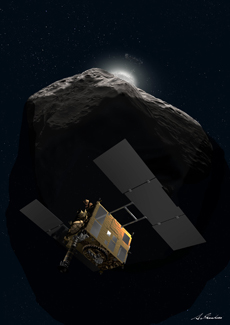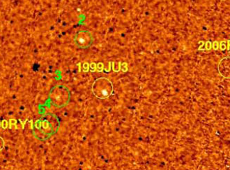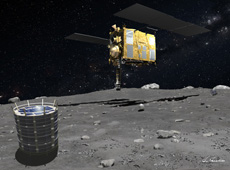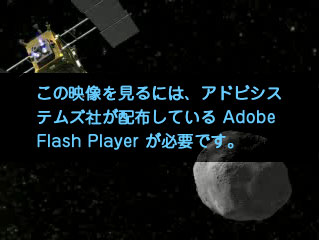TOP >
Special > Preparing for HAYABUSA’s Successor


Q. Tell us about the spacecraft now under consideration as HAYABUSA’s successor? What is the status of the project?

Asteroid explorer HAYABUSA-2 (courtesy: Akihiro Ikeshita)
Like HAYABUSA, HAYABUSA-2 is a sample-return mission, to travel to an asteroid to collect and return samples. Asteroids are grouped according to the spectral shape of reflected sunlight. HAYABUSA explored the S-type asteroid Itokawa; HAYABUSA-2 will explore the C-type asteroid 1999 JU3. The size of HAYABUSA-2 will be basically the same as HAYABUSA, but it will be improved based on our experience with the first mission.
HAYABUSA arrived at Itokawa in 2005, but failed to collect samples as planed. It is possible to make assumptions about the material composition of asteroids from meteorites that have fallen to Earth, but those assumptions can only be confirmed when we can get actual samples from an asteroid. A successful sample return is our major goal. We wanted to attempt the mission one more time, and in 2006 we made a proposal for HAYABUSA’s successor.
The HAYABUSA-2 project preparation team has been working on for the mission since it was brought together in June 2007. The return of HAYABUSA last June generated a lot of public support for our mission, and in August, the Space Activities Commission approved the development of HAYABUSA-2. Whether we’ll get the budget for it is still up for deliberation, but I’m hoping that decision will be made by the end of this year.

Q. Why was asteroid 1999JU3 selected as the destination of HAYABUSA-2?

Asteroid 1999JU3 (in the yellow circle in the center of the image), imaged by the infrared astronomical satellite AKARI
The answer is that 1999JU3 is a C-type asteroid. Asteroids are grouped into different types according to their spectral characteristics, and many can be classified as Type C or Type S. The main ingredient of C-type asteroids is carbon-based materials, and about 75% of all asteroids are thought to belong to this type. In contrast, the main ingredient of S-type asteroids is silicon, and 20% of all asteroids are estimated to be this type. HAYABUSA’s asteroid, Itokawa, is an S-type. It is essential to understand these two types if you wish to understand asteroids in general.
Many S-types are in the asteroid belt located between the orbits of Mars and Jupiter, and some of them approach close to Earth. On the other hand, C-types are situated outside the asteroid belt, and few of these asteroids have orbits that get close to Earth. 1999JU3 is an exception - it approaches close enough to Earth’s orbit for a small spacecraft such as HAYABUSA-2 to make a round trip there.
HAYABUSA was originally a technology demonstration spacecraft - its primary goal was to establish new technologies. HAYABUSA-2, on the other hand, will focus on both technology and science, so the selection of the asteroid is crucial. Since an S-type asteroid was chosen last time, we decided on a C-type for Hayabusa-2. We’ve been preparing for the mission by conducting ground-based observation of 1999JU3. I can’t wait for the day when we can finally see it up close.
Q. What can we learn from asteroid?
The Solar System was born about 4.6 billion years ago. Interstellar gas in space gradually condensed to form the Sun at the center; then a disk was formed around it, and "dust" in this disk aggregated to form the planets. By studying an asteroid, we hope to identify the "dust" that formed the Earth.
Although the Earth was once molten and information on its past was lost asteroids are thought to contain materials unchanged since the birth of the Solar System. In particular, the surface material of a C-type asteroid, which is the destination of HAYABUSA-2, may be abundant in organic matters. It is also thought that such asteroid has rocks that contain water, which are called hydrated minerals. By studying the minerals that made our planet, the water that formed our oceans, and the materials that became the ingredients of organic compounds that formed life, we will be able to get a deeper understanding of the birth of the Solar System and the Earth, as well as the origin of life on our planet.

Q. How is the technology designed for HAYABUSA going to be reflected in HAYABUSA-2? What will be the major improvements?

Asteroid explorer HAYABUSA-2 and MINERVA (courtesy: Akihiro Ikeshita)
HAYABUSA was primarily a technology demonstrator, and was a very challenging mission. Some technologies were successful and some failed. But, basically, many technologies that were tried out with HAYABUSA will be passed on to HAYABUSA-2.
First among those are the ion engines. Despite the fact that HAYABUSA’s ion engines degraded over time and did not perform optimally, it achieved the world’s first planetary round trip. We would like to advance electric propulsion technology further, and build ion engines with a longer lifespan.
Next is the navigation and guidance technology. This technology is used for touchdown - for the spacecraft to land on the surface of the asteroid, and ascend again after collecting samples. HAYABUSA’s fuel leak problem is suspected to have occurred because the touchdown was not performed properly. False landing must not happen again next time, and to ensure this, we are creating new methods of operation, navigation and guidance.
We are also planning a new attempt at MINERVA. MINERVA was a planetary exploration rover - Japan’s first - that was part of the HAYABUSA mission, but unfortunately it failed to land on Itokawa and drifted into space. This time, we want to make sure it succeeds.
In addition, we are planning to improve the attitude control, the antennae, and the sample-collection method. But most functions will be basically the same as HAYABUSA’s. The goal of HAYABUSA-2 is to perfect the technology developed for HAYABUSA, in order to perform a flawless planetary round trip.
Q. What are some of the new challenges with HAYABUSA-2 that were not seen with HAYABUSA?
Asteroid explorer HAYABUSA-2
The main one is to artificially create a crater on the surface of the asteroid. The HAYABUSA-2 spacecraft will be equipped with a small impact device, which will separate from HAYABUSA-2 several hundred meters above the asteroid’s surface and descend slowly. In the meanwhile, the spacecraft will move behind the asteroid, in order to get out of the "line of fire." The impact device contains an explosive that will detonate on impact with the asteroid, and the scattered fragments could damage the spacecraft, so it has to get out of the way. The explosion of the impact device will create an artificial crater on the asteroid’s surface several meters in diameter and between 50 centimeters and one meter deep. In the process, subsurface materials will be brought to the surface, so that we can study both surface and subsurface materials. The influence of cosmic radiation is less pronounced below the surface of an asteroid, so there is a higher chance that past conditions have been preserved there. We would like to carry out two touchdowns to collect samples of both surface and subsurface materials. However, as far as subsurface materials are concerned, we never really know what kind of crater will be created until we try, so we will collect them only if it is possible. We will not take unnecessary risks.




